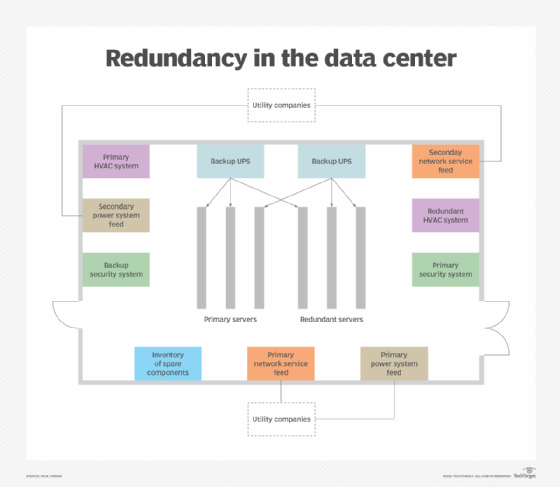What Happens to Redundancy If Company Goes Bust? A Guide to Your Rights
What Happens to Redundancy If Company Goes Bust? A Guide to Your Rights
Blog Article
Checking Out the Operational Characteristics of Business Redundancy and Its Long-Term Sustainability

Redundancy Strategies for Business Connection
In order to guarantee undisturbed procedures, businesses need to execute effective redundancy strategies for service continuity. Redundancy in this context describes the replication of crucial parts or features within a system to minimize the influence of potential failures. By integrating redundancy approaches, organizations can improve their strength versus disruptions created by different factors such as natural calamities, tools failings, or cyber-attacks.
One common redundancy technique is the execution of backup systems and data storage space services. This includes creating matches of important information and systems that can be triggered in situation of a key system failing. In addition, organizations can develop redundant interaction networks and source of power to keep connectivity and operations throughout unanticipated occasions.
Moreover, cross-training workers to do multiple functions within the firm can act as an important redundancy strategy. If vital personnel are unavailable due to ailment or various other reasons, this makes certain that vital tasks can still be carried out also. Generally, effective redundancy approaches are vital for companies to promote functional continuity and decrease the impact of possible interruptions.
Influence of Redundancy on Organizational Resilience
Given the critical duty redundancy approaches play in ensuring company continuity, discovering the impact of redundancy on organizational resilience becomes essential for recognizing the alternative functional characteristics of a company. Redundancy, when strategically applied, can significantly add to boosting an organization's resilience in the face of unforeseen difficulties.
Furthermore, redundancy can cultivate technology and creative thinking within an organization as employees feel empowered to take calculated risks, understanding that there is a safety internet to support them in case of failing. In general, the influence of redundancy on business resilience is extensive, shaping the long-term sustainability and success of a company.
Balancing Performance and Adaptability in Redundancy
Achieving an unified balance between functional effectiveness and adaptive flexibility is a critical difficulty in the critical implementation of redundancy within companies. As well much versatility without a strong functional foundation can result in inefficiencies and variance.
To stabilize performance and flexibility in redundancy planning, organizations should meticulously analyze their operational demands, market dynamics, and tactical goals. Inevitably, finding the ideal equilibrium between efficiency and adaptability is crucial for building a lasting and resistant company in the face of unpredictability.
Long-Term Sustainability With Redundancy Preparation
To guarantee enduring feasibility and security, companies have to purposefully align their redundancy preparation with lasting sustainability objectives, thereby harmonizing operational performance with flexible versatility. Lasting sustainability with redundancy planning involves greater than just short-term cost-cutting measures. It needs a detailed tactical approach that prepares for future obstacles and chances. Firms ought to see redundancy not as a responsive option to prompt troubles but as a proactive approach for long-term success. By integrating redundancy preparation with sustainability objectives, companies can develop a resilient framework that can hold up against various market variations and inner modifications.

Proactive Measures for Lasting Firm Procedures
Exactly how can firms proactively boost their functional sustainability for long-term success? Executing positive measures is vital for companies aiming to make sure lasting operations.
Moreover, fostering read a society of constant enhancement and understanding within the organization can improve versatility to transforming market problems and client needs. Encouraging worker involvement in decision-making processes and supplying possibilities for expert growth can enhance morale, performance, and general performance. Developing clear objectives, keeping an eye on key efficiency indications, and regularly assessing progress are vital components of proactive sustainability monitoring.
Teaming up with providers, clients, and various other stakeholders to advertise sustainable techniques throughout the supply chain can create a causal sequence of favorable effect - redundancy pay if company goes bust. By taking positive actions towards operational sustainability, companies can build durability, drive innovation, and protect their long-lasting success in an ever-evolving organization landscape
Conclusion

In the world of business administration, the critical implementation of firm redundancy stands as a crucial yet intricate method that requires a delicate balance between operational performance and long-lasting viability. By studying the functional characteristics that underpin firm redundancy and assessing its more comprehensive effects for organizational durability and flexibility, a nuanced understanding of just how redundancy techniques can shape the future trajectory of a business starts to unravel.Given the important role redundancy techniques play in making sure service continuity, my sources discovering the impact of redundancy on organizational durability ends up being necessary for recognizing the holistic operational dynamics of a business. On the whole, the impact of redundancy on business strength is profound, shaping the lasting sustainability and success of a company.
In verdict, recognizing the operational characteristics of business redundancy is critical for making certain long-lasting sustainability.
Report this page